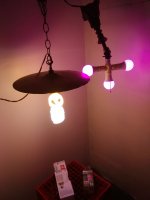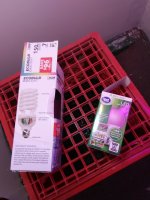I'mOne
Well-Known Member
Ok so I painted my grow room and bought seeds. I rigged up some lighting and want your opinions. My seeds are the auto fem Malawi, one Kali China, some Kushage bags seeds, with Lebanese and Panama as well as Bubba Hash on the way from Ace. I also purchased some CopperChem seeds from Greenpoint. All are regular seeds except the lebs and the Malawi. My lights are one fixture made from an old chandelier and a zildjan cymbal with three way adaptor to plug three bulbs in. Those are two regular 60 watt CFLs and a 150 watt CFLs equivalent and another lamp is fixed up similar with grow bulb 60 watt equivalent led. I plan in starting some seeds then possibly moving them out doors in April ? The Malawi's are the only auto flower seeds. I have potting soil with no fertilizer from Walmart. It has 20% perlite. I have fabric bags to transfer them into after they get too big for the peat pots.
Should I run Malawi's and a bagseed? Or one of each? Do I need more lighting for three plants? Suggestions please? Is this a good set up to start with?
Should I run Malawi's and a bagseed? Or one of each? Do I need more lighting for three plants? Suggestions please? Is this a good set up to start with?





 ), and you can't beat the price, lol. You can slice one top-to-bottom, make a partial cut around the top and around the bottom, and open it up like a wing(?). The bottom can be left on and simply bent outwards a bit to help reflect what little light comes off the top of the bulb, and the top can be cut so as to fit snugly onto the base of the bulb or the material around the socket. If done correctly, you shouldn't need to use any kind of fastener to hold it in place. It might take a few tries, but soda comes in six-packs, twelve-packs, etc. so that shouldn't be a big deal. Get the orientation straightened out - and make reflectors that mount close to the bulbs, and parallel to them - and you'll end up lighting the plants (directly) under them instead of the walls, floor, ceiling, and the entire volume of space contained within.
), and you can't beat the price, lol. You can slice one top-to-bottom, make a partial cut around the top and around the bottom, and open it up like a wing(?). The bottom can be left on and simply bent outwards a bit to help reflect what little light comes off the top of the bulb, and the top can be cut so as to fit snugly onto the base of the bulb or the material around the socket. If done correctly, you shouldn't need to use any kind of fastener to hold it in place. It might take a few tries, but soda comes in six-packs, twelve-packs, etc. so that shouldn't be a big deal. Get the orientation straightened out - and make reflectors that mount close to the bulbs, and parallel to them - and you'll end up lighting the plants (directly) under them instead of the walls, floor, ceiling, and the entire volume of space contained within.